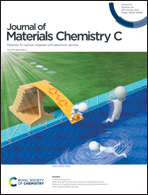Enhancing the energy harvesting performance of PDMS based piezocomposites via a synergistic effect†
Abstract
Due to the self-supplied energy requirements of wearable electronic devices, flexible piezoelectric energy harvesters (FPEHs) that can convert the vibration energy in the environment into electrical energy have received widespread attention in recent years. The key to increasing the power generation capacity of FPEHs is to increase the piezoelectric charge constant d33 while reducing the internal resistance, which is still a huge challenge for ceramic/polymer composites. In this work, a synergistic effect is used to construct FPEHs with high power generating capacity. On the one hand, a highly electroactive 0.2Pb(Zn1/3Nb2/3)O3–0.8Pb(Zr1/2Ti1/2)O3 (PZN–PZT) ceramic skeleton is constructed through a freeze-casting method to greatly increase the d33 of a PDMS based composite. On the other hand, multi-walled carbon nanotubes (MW-CNTs) are introduced as a bridging phase to reduce the internal resistance of the composite. The 2–2 type PZN–PZT/MW-CNTs/PDMS piezocomposite prepared using this strategy has a d33 as high as 144 pC N−1, which is significantly better than those of previously reported composites. The FPEH with dimensions of 1.5 × 1.5 × 0.1 cm3 can light 22 LEDs through the rectifier circuit without any storage units, showing an important application prospect for self-supply of energy in wearable electronic devices.



 Please wait while we load your content...
Please wait while we load your content...